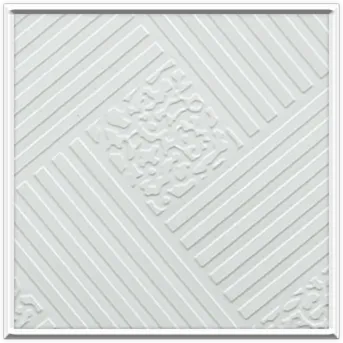9 月 . 23, 2024 19:47 Back to list
Mineral Fiber Ceiling Tiles for Enhanced Acoustics and Aesthetic Appeal
Understanding Mineral Fiber Grid Ceilings Benefits and Applications
Mineral fiber grid ceilings, commonly known as drop ceilings or acoustic ceilings, are a popular choice in many commercial and residential buildings. These ceilings consist of tiles made from mineral fibers suspended from a framework or grid system. The unique composition and design of mineral fiber ceilings provide a range of benefits, making them an ideal option for various applications.
Composition and Features
Mineral fiber ceiling tiles are primarily made from natural materials such as gypsum, wood, or mineral wool, combined with binders and additives. This composition gives them excellent acoustic properties, fire resistance, and thermal insulation. The tiles typically come in different textures, colors, and patterns, which can enhance the aesthetic appeal of any space. The grid system used to suspend the tiles allows for easy installation and access to utilities above the ceiling, making maintenance and modifications straightforward.
Acoustic Performance
One of the key advantages of mineral fiber grid ceilings is their sound-absorbing capabilities. The porous nature of the mineral fibers helps to reduce noise levels within a space, making them ideal for offices, schools, and conference rooms where speech intelligibility and sound control are critical. The automatic noise reduction contributes significantly to creating a more productive and comfortable environment, allowing occupants to focus on their tasks without the distraction of ambient noise.
Fire Resistance
Safety is a paramount concern in building design, and mineral fiber ceilings excel in fire resistance. Most mineral fiber tiles meet stringent fire safety standards and are classified as non-combustible. This property provides peace of mind to building owners and occupants, knowing that these ceilings can help slow the spread of fire and provide vital extra time for evacuation during emergencies.
mineral fiber grid ceiling

Thermal Insulation
Mineral fiber grid ceilings also offer exceptional thermal insulation properties. They can help maintain a building's temperature by reducing heat loss in winter and keeping spaces cooler in summer. This energy efficiency can lead to lower heating and cooling costs, making mineral fiber ceilings a cost-effective choice for long-term building management. Additionally, the thermal benefits contribute to a more comfortable environment, enhancing the overall experience of those utilizing the space.
Versatility and Design Flexibility
Another significant advantage of mineral fiber grid ceilings is their versatility. They can be used in a wide range of applications, from commercial office spaces to healthcare facilities and educational institutions. The variety of styles and finishes available allows architects and designers to incorporate these ceilings seamlessly into their design concepts while fulfilling practical requirements. Furthermore, the grid ceiling system can easily accommodate lighting fixtures, air ducts, and other utilities, making them an efficient choice for modern construction.
Environmental Considerations
Many manufacturers are increasingly focused on sustainability, and mineral fiber ceiling tiles can be a part of that movement. Many products are made from recycled materials and may be recyclable at the end of their life cycle. This commitment to environmental responsibility appeals to eco-conscious builders and occupants alike.
Conclusion
In conclusion, mineral fiber grid ceilings provide a blend of acoustic performance, fire resistance, thermal insulation, and design flexibility, making them an ideal choice for various applications. As building designs continue to evolve, these ceilings remain a reliable and effective solution to meet both aesthetic and functional needs. Whether in a bustling office or a quiet classroom, mineral fiber ceilings contribute to creating environments that are not only safe but also conducive to productivity and comfort.
-
Revolutionizing Interior Design with Ceilings t grid Suspended SystemNewsOct.29,2024
-
Revolutionizing Ceiling Design with ceiling access panel with Gypsum Tile WaterproofNewsOct.29,2024
-
Revolutionizing Interior Design with PVC Gypsum Ceiling: A Comprehensive GuideNewsOct.29,2024
-
Elevating Interior Design with High quality Mineral Fiber Ceiling TilesNewsOct.29,2024
-
Revolutionizing Interior Design with PVC Gypsum Ceiling: A Comprehensive GuideNewsOct.29,2024
-
Elevating Interior Design with High-Quality Mineral Fiber Ceiling Tiles: A Comprehensive GuideNewsOct.29,2024







